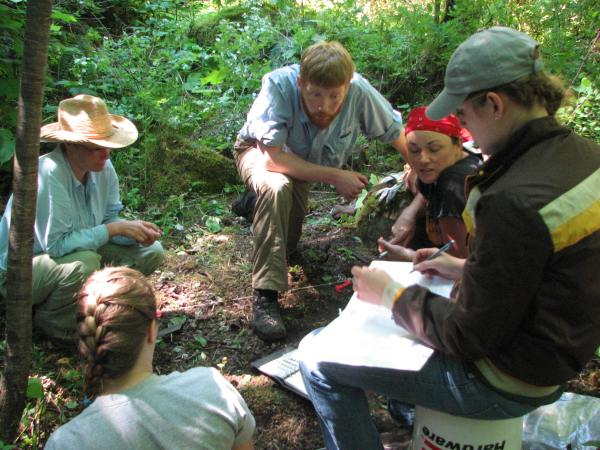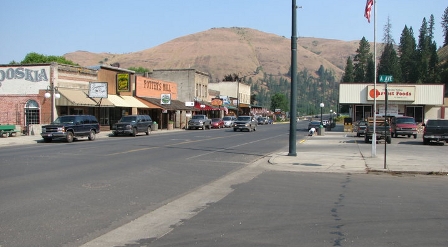
The Kooskia Internment Camp Archaeology Project began in the summer of 2010, when Dr. Camp and her team of faculty, post-doctoral, graduate and undergraduate researchers performed preliminary archaeological research at Kooskia. Their work included a geophysical survey, soil resistivity studies, shovel testing, phosphate analysis and collected macrobotanical soil samples to determine the location, extent, integrity and contents of historic gardens and personal effects from the camp's internees and employees.
The team conducted phase two archaeological research during the summer of 2013, excavating a trash dump associated with the internees and prisoners held at the Kooskia Internment Camp. To learn more about the results of the fieldwork, please visit the project blog.
In addition to fieldwork, KICAP involved reexamining sources cited by historians and archaeologists who have written about the region or site. The team undertook a thorough scan of local newspapers and publications for information on Kooskia, including the Kooskia Mountaineer, Lewiston Morning Tribune, Lochsa Pioneer (literary magazine written by prisoners at Canyon Creek Camp), Orofino Idaho County Free Press and the Clearwater Tribune. Dr. Camp also examined archival information held at the National Archives in Washington, D.C.
Kooskia Internment Camp
On February 19, 1942, over 120,000 individuals of Japanese heritage were forced to leave the comfort and solace of their homes and communities and relocate to internment camps spread throughout some of the harshest and most destitute locales in the Western United States (Helphand 2006:156). Seen as enemies of the state during World War II, Japanese Americans were given an ultimatum: abandon their homes within six to twenty-one days or be imprisoned. The state of Idaho played a crucial role in Japanese internment as it was home to two sites of confinement: Kooskia (Wegars 2001) and Minidoka (Burton et al. 2003).

Two hundred and fifty-six male Japanese internees occupied Kooskia Internment Camp between May 1943 and 1945, while Minidoka Relocation Center housed over 7000 individuals of Japanese heritage from August 1942 to 1945. Minidoka has been the subject of substantial historical and archaeological research, while Kooskia had remained a neglected historic site, perhaps partially due to its remote location. As well-known Japanese and Chinese historian and archaeological scholar Priscilla Wegars poignantly describes, "except for a concrete slab where the water tower once stood, and level areas that held the former buildings, almost nothing remains to remind us of the Kooskia Internment Camp's place in Japanese American, and American, history" (2001:167).
Internees at Kooskia Internment Camp continued the construction of the Lewis and Clark Highway (U.S. Highway 12) between Idaho and Montana, work previously charged to federal prison detainees. Consequently, Kooskia Internment Camp represents the U.S. government's first attempt to use internees as a work force. The camp was also notable in that many of the internees were South Americans of Japanese heritage, forcibly removed by the United States government from countries such as Peru, Mexico and Panama for potential use in prisoner exchanges with Japan for U.S. nationals.
Historical Background
Kooskia Internment Camp has a complex, multilayered occupational history that spans both prehistoric and historic periods. The site is known to be a long-term camping and hunting ground of the Nez Perce tribe (Sappington and Carley 1989). New visitors arrived in the 1800s and early 1900s. In September 1893, 27 year-old William P. Carlin of Vancouver, 28 year-old engineer A. L. A. Himmelwright and 30 year-old John Harvey Pierce of While Plains, New York, met in Spokane and set out for a hunting trip along in the vicinity of Kooskia Internment Camp. They were guided by Martin C. Spencer and brought 52 year-old George Colegate of Post Falls, Idaho, along as a cook. During their trek, they camped at Apgar Creek and fished at the mouth of Canyon Creek (Space 1980:40).

A Civilian Conservation Corps (CCC) camp, which also went by the names of Camp F-38 and Camp 38, was built along the Lochsa River in June 1933 (Sappington and Carley 1989:16). It housed 200 individuals who constructed roads, established telephone lines and fought fires (Sappington and Carley 1989:16). The camp closed in October 1933.
Two years later (August 1935), the CCC camp was once again occupied by "federal convicts from Ft. Leavenworth, Kansas, along with officials and guards" (Elsensohn 1951:55 in Sappington and Carley 1989:16). Now known as Canyon Creek Prison Camp, its residents were charged with the task of constructing the Lewis and Clark Highway (Parsell 1986:40). The camp was closed in 1943 due to "war-related expenses" amassed by the Justice Bureau of Prisons (Wegars 2001:146) and soon became Kooskia Internment Camp. Many of the buildings and landscapes that the Japanese internees would later occupy were built in conjunction with Canyon Creek Prison Camp (Sappington and Carley1989:16).
